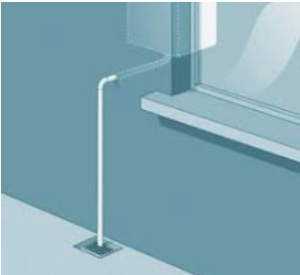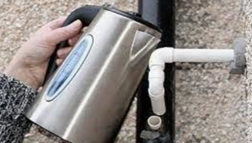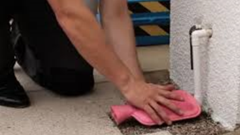Some pipes may freeze during the winter – this will usually be a condensate pipe from a condensing boiler. This page tells you how to unfreeze a condensate pipe.
If you can’t unfreeze it yourself and you have no heating, request an emergency repair.
Who this guidance is for
This guide is intended for residents living in ground floor flats, bungalows and houses where the condensate pipe is located on the ground floor.
Some boilers in conventional houses are located on the first floor, making them unreachable to thaw.
If you are can’t thaw your condensate pipes, let our repairs team know so that we can arrange for a heating engineer to carry out the work.
Find your condensate pipe
All condensing boilers have a condensate pipe which sends waste water outside and down a drain.
They’re always plastic. They are usually a small 1 inch (21.5mm) white pipe passing through the wall from the boiler and either leading directly to a small drain or connecting into another drain pipe on the outside of your home.

Being outside during the winter months means that the water running out of the condensate pipes is prone to freezing. Any water that freezes inside the pipe ends up blocking more water from escaping through the pipe, meaning that water builds up in the boiler. To prevent serious damage to the boiler from flooding, it will switch itself off until the frozen condensate pipe has been thawed out.
Check if your condensate pipe is frozen
Before attempting to unfreeze a condensate pipe, you first need to ensure that this is the cause of the fault.
In many cases, your boiler will display an error code to make you aware but if your boiler doesn’t then it can often be recognised by a gurgling noise coming from your heating system. If your boiler has been working well up until a period of below freezing temperatures then that’s a strong indication that the condensate pipe has frozen.
Frozen condensate pipe error codes
Some boilers will display an error code when the condensate pipe has frozen to make you aware of the issue. Use the table below to find the error code your boiler will display when you have a frozen condensate pipe.
| Manufacturer | Error code |
| ATAG | 133 |
| Baxi | E133 or E28 |
| Glow-worm | F1, F4, F28 or F29 |
| Ideal | FL |
| Main | E133 |
| Potterton | E133 |
| Vaillant | F28 or F29 |
| Viessmann | F4EE |
| Worcester Bosch | EA229 D5 |
How to thaw a condensate pipe
If your condensate pipe has frozen, don’t worry, this can be resolved in just a few steps without even having to contact a heating engineer.
It’s important to find the blockage before taking any further actions so that you know you’re thawing out the right part of the pipe. This often occurs where there is a bend or dip in the pipe.
Once you’ve located the blockage, there are several ways that you can unfreeze the condensate pipe:
- Apply a hot water bottle, microwaveable heating pack or warm cloth to the frozen part of the pipe.
- Pour warm water over the frozen part of the condensate pipe using a watering can.
- Do not use boiling water as it could cause the plastic pipe to melt or split due to the sudden temperature change to boiling water.
- Always be careful when pouring warm water if the pipe is at a slightly higher level.
- Pro tip – Always work from the open pipe end (drain or connection end) back towards the building. This will hopefully help prevent melted ice water from re-freezing as it is still stuck behind the frozen plug.



After unfreezing the pipe, you might need to reset the boiler to get it going again. Some boilers will reset automatically, so it’s best to take a look in the boiler’s manual (or online) for next steps.
Getting help to thaw your condensate pipes
If you’re not able to thaw a frozen condensate pipe yourself, have any doubts, or are not confident to do it yourself, please let us know about your loss of heating so that we can arrange a heating engineer to carry out the work.
